Chapter 5.9: Newton’s Method
Learning Objectives
- Describe the steps of Newton’s method.
- Explain what an iterative process means.
- Recognize when Newton’s method does not work.
- Apply iterative processes to various situations.
In many areas of pure and applied mathematics, we are interested in finding solutions to an equation of the form ![]() For most functions, however, it is difficult—if not impossible—to calculate their zeroes explicitly. In this section, we take a look at a technique that provides a very efficient way of approximating the zeroes of functions. This technique makes use of tangent line approximations and is behind the method used often by calculators and computers to find zeroes.
For most functions, however, it is difficult—if not impossible—to calculate their zeroes explicitly. In this section, we take a look at a technique that provides a very efficient way of approximating the zeroes of functions. This technique makes use of tangent line approximations and is behind the method used often by calculators and computers to find zeroes.
Describing Newton’s Method
Consider the task of finding the solutions of ![]() If
If ![]() is the first-degree polynomial
is the first-degree polynomial ![]() then the solution of
then the solution of ![]() is given by the formula
is given by the formula ![]() If
If ![]() is the second-degree polynomial
is the second-degree polynomial ![]() the solutions of
the solutions of ![]() can be found by using the quadratic formula. However, for polynomials of degree 3 or more, finding roots of
can be found by using the quadratic formula. However, for polynomials of degree 3 or more, finding roots of ![]() becomes more complicated. Although formulas exist for third- and fourth-degree polynomials, they are quite complicated. Also, if
becomes more complicated. Although formulas exist for third- and fourth-degree polynomials, they are quite complicated. Also, if ![]() is a polynomial of degree 5 or greater, it is known that no such formulas exist. For example, consider the function
is a polynomial of degree 5 or greater, it is known that no such formulas exist. For example, consider the function
No formula exists that allows us to find the solutions of ![]() Similar difficulties exist for nonpolynomial functions. For example, consider the task of finding solutions of
Similar difficulties exist for nonpolynomial functions. For example, consider the task of finding solutions of ![]() No simple formula exists for the solutions of this equation. In cases such as these, we can use Newton’s method to approximate the roots.
No simple formula exists for the solutions of this equation. In cases such as these, we can use Newton’s method to approximate the roots.
Newton’s method makes use of the following idea to approximate the solutions of ![]() By sketching a graph of
By sketching a graph of ![]() we can estimate a root of
we can estimate a root of ![]() Let’s call this estimate
Let’s call this estimate ![]() We then draw the tangent line to
We then draw the tangent line to ![]() at
at ![]() If
If ![]() this tangent line intersects the
this tangent line intersects the ![]() -axis at some point
-axis at some point ![]() Now let
Now let ![]() be the next approximation to the actual root. Typically,
be the next approximation to the actual root. Typically, ![]() is closer than
is closer than ![]() to an actual root. Next we draw the tangent line to
to an actual root. Next we draw the tangent line to ![]() at
at ![]() If
If ![]() this tangent line also intersects the
this tangent line also intersects the ![]() -axis, producing another approximation,
-axis, producing another approximation, ![]() We continue in this way, deriving a list of approximations:
We continue in this way, deriving a list of approximations: ![]() Typically, the numbers
Typically, the numbers ![]() quickly approach an actual root
quickly approach an actual root ![]() as shown in the following figure.
as shown in the following figure.

 approach the actual root
approach the actual root  The approximations are derived by looking at tangent lines to the graph of
The approximations are derived by looking at tangent lines to the graph of 
Now let’s look at how to calculate the approximations ![]() If
If ![]() is our first approximation, the approximation
is our first approximation, the approximation ![]() is defined by letting
is defined by letting ![]() be the
be the ![]() -intercept of the tangent line to
-intercept of the tangent line to ![]() at
at ![]() The equation of this tangent line is given by
The equation of this tangent line is given by
Therefore, ![]() must satisfy
must satisfy
Solving this equation for ![]() we conclude that
we conclude that
Similarly, the point ![]() is the
is the ![]() -intercept of the tangent line to
-intercept of the tangent line to ![]() at
at ![]() Therefore,
Therefore, ![]() satisfies the equation
satisfies the equation
In general, for ![]() satisfies
satisfies
Next we see how to make use of this technique to approximate the root of the polynomial ![]()
Finding a Root of a Polynomial
Use Newton’s method to approximate a root of ![]() in the interval
in the interval ![]() Let
Let ![]() and find
and find ![]() and
and ![]()
Show Answer
From (Figure), we see that ![]() has one root over the interval
has one root over the interval ![]() Therefore
Therefore ![]() seems like a reasonable first approximation. To find the next approximation, we use (Figure). Since
seems like a reasonable first approximation. To find the next approximation, we use (Figure). Since ![]() the derivative is
the derivative is ![]() Using (Figure) with
Using (Figure) with ![]() (and a calculator that displays 10 digits), we obtain
(and a calculator that displays 10 digits), we obtain
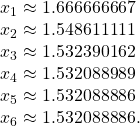

 has one root over the interval
has one root over the interval ![Rendered by QuickLaTeX.com \left[1,2\right].](https://ecampusontario.pressbooks.pub/app/uploads/quicklatex/quicklatex.com-e5437b7a8c15671d00f848f7fe357a33_l3.png)
Letting ![]() let’s use Newton’s method to approximate the root of
let’s use Newton’s method to approximate the root of ![]() over the interval
over the interval ![]() by calculating
by calculating ![]() and
and ![]()
Solution
![]()
Newton’s method can also be used to approximate square roots. Here we show how to approximate ![]() This method can be modified to approximate the square root of any positive number.
This method can be modified to approximate the square root of any positive number.
Finding a Square Root
Use Newton’s method to approximate ![]() ((Figure)). Let
((Figure)). Let ![]() let
let ![]() and calculate
and calculate ![]() (We note that since
(We note that since ![]() has a zero at
has a zero at ![]() the initial value
the initial value ![]() is a reasonable choice to approximate
is a reasonable choice to approximate ![]() )
)
Solution
For ![]() From (Figure), we know that
From (Figure), we know that
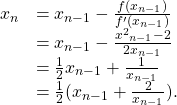
Therefore,
Continuing in this way, we find that
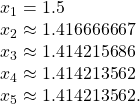
Since we obtained the same value for ![]() and
and ![]() it is unlikely that the value
it is unlikely that the value ![]() will change on any subsequent application of Newton’s method. We conclude that
will change on any subsequent application of Newton’s method. We conclude that ![]()


When using Newton’s method, each approximation after the initial guess is defined in terms of the previous approximation by using the same formula. In particular, by defining the function ![]() we can rewrite (Figure) as
we can rewrite (Figure) as ![]() This type of process, where each
This type of process, where each ![]() is defined in terms of
is defined in terms of ![]() by repeating the same function, is an example of an iterative process. Shortly, we examine other iterative processes. First, let’s look at the reasons why Newton’s method could fail to find a root.
by repeating the same function, is an example of an iterative process. Shortly, we examine other iterative processes. First, let’s look at the reasons why Newton’s method could fail to find a root.
Failures of Newton’s Method
Typically, Newton’s method is used to find roots fairly quickly. However, things can go wrong. Some reasons why Newton’s method might fail include the following:
- At one of the approximations
 the derivative
the derivative  is zero at
is zero at  but
but  As a result, the tangent line of
As a result, the tangent line of  at
at  does not intersect the
does not intersect the  -axis. Therefore, we cannot continue the iterative process.
-axis. Therefore, we cannot continue the iterative process. - The approximations
 may approach a different root. If the function
may approach a different root. If the function  has more than one root, it is possible that our approximations do not approach the one for which we are looking, but approach a different root (see (Figure)). This event most often occurs when we do not choose the approximation
has more than one root, it is possible that our approximations do not approach the one for which we are looking, but approach a different root (see (Figure)). This event most often occurs when we do not choose the approximation  close enough to the desired root.
close enough to the desired root. - The approximations may fail to approach a root entirely. In (Figure), we provide an example of a function and an initial guess
 such that the successive approximations never approach a root because the successive approximations continue to alternate back and forth between two values.
such that the successive approximations never approach a root because the successive approximations continue to alternate back and forth between two values.
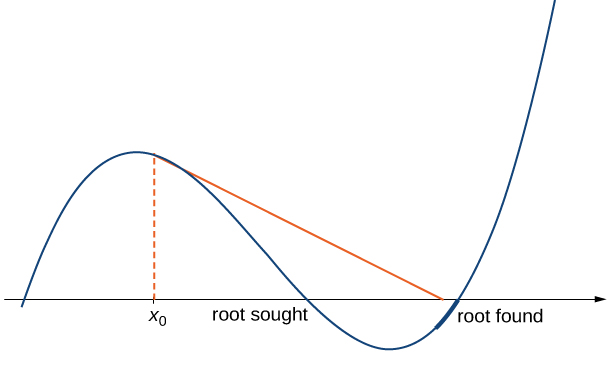
 is too far from the root sought, it may lead to approximations that approach a different root.
is too far from the root sought, it may lead to approximations that approach a different root.When Newton’s Method Fails
Consider the function ![]() Let
Let ![]() Show that the sequence
Show that the sequence ![]() fails to approach a root of
fails to approach a root of ![]()
Solution
For ![]() the derivative is
the derivative is ![]() Therefore,
Therefore,
In the next step,
Consequently, the numbers ![]() continue to bounce back and forth between 0 and 1 and never get closer to the root of
continue to bounce back and forth between 0 and 1 and never get closer to the root of ![]() which is over the interval
which is over the interval ![]() (see (Figure)). Fortunately, if we choose an initial approximation
(see (Figure)). Fortunately, if we choose an initial approximation ![]() closer to the actual root, we can avoid this situation.
closer to the actual root, we can avoid this situation.

 and never approach the root of
and never approach the root of 
From (Figure), we see that Newton’s method does not always work. However, when it does work, the sequence of approximations approaches the root very quickly. Discussions of how quickly the sequence of approximations approach a root found using Newton’s method are included in texts on numerical analysis.
Other Iterative Processes
As mentioned earlier, Newton’s method is a type of iterative process. We now look at an example of a different type of iterative process.
Consider a function ![]() and an initial number
and an initial number ![]() Define the subsequent numbers
Define the subsequent numbers ![]() by the formula
by the formula ![]() This process is an iterative process that creates a list of numbers
This process is an iterative process that creates a list of numbers ![]() This list of numbers may approach a finite number
This list of numbers may approach a finite number ![]() as
as ![]() gets larger, or it may not. In (Figure), we see an example of a function
gets larger, or it may not. In (Figure), we see an example of a function ![]() and an initial guess
and an initial guess ![]() such that the resulting list of numbers approaches a finite value.
such that the resulting list of numbers approaches a finite value.
Finding a Limit for an Iterative Process
Let ![]() and let
and let ![]() For all
For all ![]() let
let ![]() Find the values
Find the values ![]() Make a conjecture about what happens to this list of numbers
Make a conjecture about what happens to this list of numbers ![]() as
as ![]() If the list of numbers
If the list of numbers ![]() approaches a finite number
approaches a finite number ![]() then
then ![]() satisfies
satisfies ![]() and
and ![]() is called a fixed point of
is called a fixed point of ![]()
Solution
If ![]() then
then
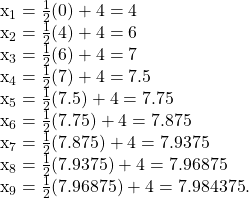
From this list, we conjecture that the values ![]() approach 8.
approach 8.
(Figure) provides a graphical argument that the values approach 8 as ![]() Starting at the point
Starting at the point ![]() we draw a vertical line to the point
we draw a vertical line to the point ![]() The next number in our list is
The next number in our list is ![]() We use
We use ![]() to calculate
to calculate ![]() Therefore, we draw a horizontal line connecting
Therefore, we draw a horizontal line connecting ![]() to the point
to the point ![]() on the line
on the line ![]() and then draw a vertical line connecting
and then draw a vertical line connecting ![]() to the point
to the point ![]() The output
The output ![]() becomes
becomes ![]() Continuing in this way, we could create an infinite number of line segments. These line segments are trapped between the lines
Continuing in this way, we could create an infinite number of line segments. These line segments are trapped between the lines ![]() and
and ![]() The line segments get closer to the intersection point of these two lines, which occurs when
The line segments get closer to the intersection point of these two lines, which occurs when ![]() Solving the equation
Solving the equation ![]() we conclude they intersect at
we conclude they intersect at ![]() Therefore, our graphical evidence agrees with our numerical evidence that the list of numbers
Therefore, our graphical evidence agrees with our numerical evidence that the list of numbers ![]() approaches
approaches ![]() as
as ![]()


Consider the function ![]() Let
Let ![]() and let
and let ![]() for
for ![]() Find
Find ![]() Make a conjecture about what happens to the list of numbers
Make a conjecture about what happens to the list of numbers ![]() as
as ![]()
Solution
![]()
Hint
Consider the point where the lines ![]() and
and ![]() intersect.
intersect.
Iterative Processes and Chaos
Iterative processes can yield some very interesting behavior. In this section, we have seen several examples of iterative processes that converge to a fixed point. We also saw in (Figure) that the iterative process bounced back and forth between two values. We call this kind of behavior a 2-cycle. Iterative processes can converge to cycles with various periodicities, such as ![]() (where the iterative process repeats a sequence of four values), 8-cycles, and so on.
(where the iterative process repeats a sequence of four values), 8-cycles, and so on.
Some iterative processes yield what mathematicians call chaos. In this case, the iterative process jumps from value to value in a seemingly random fashion and never converges or settles into a cycle. Although a complete exploration of chaos is beyond the scope of this text, in this project we look at one of the key properties of a chaotic iterative process: sensitive dependence on initial conditions. This property refers to the concept that small changes in initial conditions can generate drastically different behavior in the iterative process.
Probably the best-known example of chaos is the Mandelbrot set (see (Figure)), named after Benoit Mandelbrot (1924–2010), who investigated its properties and helped popularize the field of chaos theory. The Mandelbrot set is usually generated by computer and shows fascinating details on enlargement, including self-replication of the set. Several colorized versions of the set have been shown in museums and can be found online and in popular books on the subject.

In this project we use the logistic map
as the function in our iterative process. The logistic map is a deceptively simple function; but, depending on the value of ![]() the resulting iterative process displays some very interesting behavior. It can lead to fixed points, cycles, and even chaos.
the resulting iterative process displays some very interesting behavior. It can lead to fixed points, cycles, and even chaos.
To visualize the long-term behavior of the iterative process associated with the logistic map, we will use a tool called a cobweb diagram. As we did with the iterative process we examined earlier in this section, we first draw a vertical line from the point ![]() to the point
to the point ![]() We then draw a horizontal line from that point to the point
We then draw a horizontal line from that point to the point ![]() then draw a vertical line to
then draw a vertical line to ![]() and continue the process until the long-term behavior of the system becomes apparent. (Figure) shows the long-term behavior of the logistic map when
and continue the process until the long-term behavior of the system becomes apparent. (Figure) shows the long-term behavior of the logistic map when ![]() and
and ![]() (The first 100 iterations are not plotted.) The long-term behavior of this iterative process is an 8-cycle.
(The first 100 iterations are not plotted.) The long-term behavior of this iterative process is an 8-cycle.

 is presented here. The sequence of values results in an 8-cycle.
is presented here. The sequence of values results in an 8-cycle.- Let
 and choose
and choose  Either by hand or by using a computer, calculate the first 10 values in the sequence. Does the sequence appear to converge? If so, to what value? Does it result in a cycle? If so, what kind of cycle (for example,
Either by hand or by using a computer, calculate the first 10 values in the sequence. Does the sequence appear to converge? If so, to what value? Does it result in a cycle? If so, what kind of cycle (for example, 
- What happens when

- For
 and
and  calculate the first 100 sequence values. Generate a cobweb diagram for each iterative process. (Several free applets are available online that generate cobweb diagrams for the logistic map.) What is the long-term behavior in each of these cases?
calculate the first 100 sequence values. Generate a cobweb diagram for each iterative process. (Several free applets are available online that generate cobweb diagrams for the logistic map.) What is the long-term behavior in each of these cases? - Now let
 Calculate the first 100 sequence values and generate a cobweb diagram. What is the long-term behavior in this case?
Calculate the first 100 sequence values and generate a cobweb diagram. What is the long-term behavior in this case? - Repeat the process for
 but let
but let  How does this behavior compare with the behavior for
How does this behavior compare with the behavior for 
Key Concepts
- Newton’s method approximates roots of
 by starting with an initial approximation
by starting with an initial approximation  then uses tangent lines to the graph of
then uses tangent lines to the graph of  to create a sequence of approximations
to create a sequence of approximations 
- Typically, Newton’s method is an efficient method for finding a particular root. In certain cases, Newton’s method fails to work because the list of numbers
 does not approach a finite value or it approaches a value other than the root sought.
does not approach a finite value or it approaches a value other than the root sought. - Any process in which a list of numbers
 is generated by defining an initial number
is generated by defining an initial number  and defining the subsequent numbers by the equation
and defining the subsequent numbers by the equation  for some function
for some function  is an iterative process. Newton’s method is an example of an iterative process, where the function
is an iterative process. Newton’s method is an example of an iterative process, where the function ![Rendered by QuickLaTeX.com F(x)=x-\left[\frac{f(x)}{{f}^{\prime }(x)}\right]](https://ecampusontario.pressbooks.pub/app/uploads/quicklatex/quicklatex.com-04c05e72666c36dc0900b17944d7e88c_l3.png) for a given function
for a given function 
For the following exercises, write Newton’s formula as ![]() for solving
for solving ![]()
1. ![]()
2. ![]()
Solution
![]()
3. ![]()
4. ![]()
Show Answer
![]()
5. ![]()
For the following exercises, solve ![]() using the iteration
using the iteration ![]() which differs slightly from Newton’s method. Find a
which differs slightly from Newton’s method. Find a ![]() that works and a
that works and a ![]() that fails to converge, with the exception of
that fails to converge, with the exception of ![]()
6. ![]() with
with ![]()
Solution
![]() fails,
fails, ![]() works
works
7. ![]() with
with ![]()
8. What is the value of ![]() for Newton’s method?
for Newton’s method?
Solution
![]()
For the following exercises, start at
a. ![]() and
and
b. ![]()
Compute ![]() and
and ![]() using the specified iterative method.
using the specified iterative method.
9. ![]()
10. ![]()
Solution
a. ![]() b.
b. ![]()
11. ![]()
12. ![]()
Solution
a. ![]() b.
b. ![]()
13. ![]()
14. ![]()
Solution
a. ![]() b.
b. ![]()
15. ![]()
16. ![]()
Solution
a. ![]() b.
b. ![]()
For the following exercises, solve to four decimal places using Newton’s method and a computer or calculator. Choose any initial guess ![]() that is not the exact root.
that is not the exact root.
17. ![]()
18. ![]()
Solution
![]()
19. ![]()
20. ![]()
Solution
![]()
21. ![]()
22. ![]() choose
choose ![]()
Solution
0
23. ![]()
24. ![]()
Show Answer
![]()
25. ![]()
26. ![]()
Solution
0
For the following exercises, use Newton’s method to find the fixed points of the function where ![]() round to three decimals.
round to three decimals.
27. ![]()
28. ![]() on
on ![]()
Solution
4.493
29. ![]()
30. ![]()
Solution
0.159,3.146
Newton’s method can be used to find maxima and minima of functions in addition to the roots. In this case apply Newton’s method to the derivative function ![]() to find its roots, instead of the original function. For the following exercises, consider the formulation of the method.
to find its roots, instead of the original function. For the following exercises, consider the formulation of the method.
31. To find candidates for maxima and minima, we need to find the critical points ![]() Show that to solve for the critical points of a function
Show that to solve for the critical points of a function ![]() Newton’s method is given by
Newton’s method is given by ![]()
32. What additional restrictions are necessary on the function ![]()
Solution
We need ![]() to be twice continuously differentiable.
to be twice continuously differentiable.
For the following exercises, use Newton’s method to find the location of the local minima and/or maxima of the following functions; round to three decimals.
33. Minimum of ![]()
34. Minimum of ![]()
Show Solution
![]()
35. Minimum of ![]()
36. Maximum of ![]()
Solution
![]()
37. Maximum of ![]()
38. Maximum of ![]()
Solution
![]()
39. Minimum of ![]() closest non-zero minimum to
closest non-zero minimum to ![]()
40. Minimum of ![]()
Solution
![]()
For the following exercises, use the specified method to solve the equation. If it does not work, explain why it does not work.
41. Newton’s method, ![]()
42. Newton’s method, ![]()
Solution
There is no solution to the equation.
43. Newton’s method, ![]() starting at
starting at ![]()
44. Solving ![]() starting at
starting at ![]()
Solution
It enters a cycle.
For the following exercises, use the secant method, an alternative iterative method to Newton’s method. The formula is given by
45. Find a root to ![]() accurate to three decimal places.
accurate to three decimal places.
46. Find a root to ![]() accurate to four decimal places.
accurate to four decimal places.
Solution
0
47. Find a root to ![]() accurate to four decimal places.
accurate to four decimal places.
48. Find a root to ![]() accurate to four decimal places.
accurate to four decimal places.
Solution
-0.3513
49. Why would you use the secant method over Newton’s method? What are the necessary restrictions on ![]()
For the following exercises, use both Newton’s method and the secant method to calculate a root for the following equations. Use a calculator or computer to calculate how many iterations of each are needed to reach within three decimal places of the exact answer. For the secant method, use the first guess from Newton’s method.
50. ![]()
Solution
Newton: 11 iterations, secant: 16 iterations
51. ![]()
52. ![]()
Solution
Newton: three iterations, secant: six iterations
53. ![]()
54. ![]()
Solution
Newton: five iterations, secant: eight iterations
In the following exercises, consider Kepler’s equation regarding planetary orbits, ![]() where
where ![]() is the mean anomaly,
is the mean anomaly, ![]() is eccentric anomaly, and
is eccentric anomaly, and ![]() measures eccentricity.
measures eccentricity.
55. Use Newton’s method to solve for the eccentric anomaly ![]() when the mean anomaly
when the mean anomaly ![]() and the eccentricity of the orbit
and the eccentricity of the orbit ![]() round to three decimals.
round to three decimals.
56. Use Newton’s method to solve for the eccentric anomaly ![]() when the mean anomaly
when the mean anomaly ![]() and the eccentricity of the orbit
and the eccentricity of the orbit ![]() round to three decimals.
round to three decimals.
Show Solution
![]()
The following two exercises consider a bank investment. The initial investment is ![]() After 25 years, the investment has tripled to
After 25 years, the investment has tripled to ![]()
57. Use Newton’s method to determine the interest rate if the interest was compounded annually.
58. Use Newton’s method to determine the interest rate if the interest was compounded continuously.
Solution
4.394%
59. The cost for printing a book can be given by the equation ![]() Use Newton’s method to find the break-even point if the printer sells each book for
Use Newton’s method to find the break-even point if the printer sells each book for ![]()
Glossary
- iterative process
- process in which a list of numbers
 is generated by starting with a number
is generated by starting with a number  and defining
and defining  for
for 
- Newton’s method
- method for approximating roots of
 using an initial guess
using an initial guess  each subsequent approximation is defined by the equation
each subsequent approximation is defined by the equation 


Hint
Use (Figure).